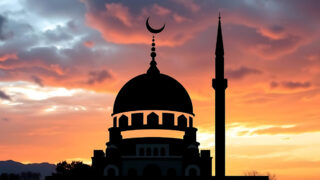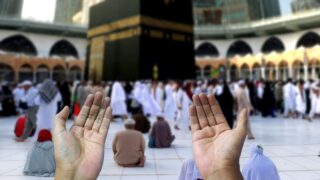Outside the world of theology, philosophy and literature, there were many Europeans whose thirst and curiosity for the Orient could not be quenched by reading books. So they went to the Islamic world and produced a sizeable literature of travel accounts about Muslim countries, their customs, cities, and so on. These were the European travelers of the 18th and 19th centuries whose ranks included such celebrities as Burton, Scott, Kinglake, Disraeli, Curzon, Warburton, Nerval, Chardin, Chateaubriand, Flaubert, Lamartine, Pierre Loti, and Tavernier.
The wealth of information these travelers brought back to Europe contributed to the popular, if not academic, perceptions of Islam and Muslims whereby the impenetrable world of the Saracens and the Orientals was now opened for many Europeans through the first-hand accounts of their fellow men and women. In some curious ways, the travel accounts of European pilgrims to the Islamic world and to the ‘Orient’ had an impact similar to that of the Crusades almost a millennium ago: a first hands-on experience of the Orient was made available for public consumption in Europe and it was entrenched not in the religious concerns and hostilities of Christian theologians but in the new mission of the Occident to ‘civilize’ the Orient – the celebrated mission civilisatrice of the colonial period.
Like their intellectual peers in the 17th and 18th centuries, those travelers were interested in the worldly qualities of Islamdom, perhaps with a good intention of dispelling some long-standing misgivings about a world in which Europe had now a vital interest or simply because Islam did not offer anything of value in view of the theological, if not historical, superiority of the Christian faith to which they belonged. Their narrations, ranging from recondite and arid inventory of names and places to spirited depictions and imaginary ruminations, display not so much interest in penetrating into the Islamic world as reflecting and constructing it through the eyes of an upper class Westerner.
A somewhat crude indication of this is the fact that many of those travelers, notwithstanding such notable exceptions as Sir Richard Burton, did not learn any of the Islamic languages or made any serious study of the beliefs and practices of Muslims other than what was available to them in Europe as common knowledge. An important outcome of this literature was what Said called ‘Orientalizing the Orient’, viz., the further romanticizing of Muslim peoples, reinforcing the mystique of the Orient, the exotic harem, the sensuous East, the Oriental man and his concubines, streets immersed in mystery, and so on, all of which are to be seen vividly in the naturalistic European paintings of the Orient in the 19th century. Needless to say, these images of the Orient are still alive in the Western mind and continue to be an inexhaustible resource for Hollywood constructions of Islam and Muslims.
It would not be a stretch to say that the 19th century is the longest period in the history Islam and the West. It was in this century that the academic study of Islam exploded more than any one in Europe could have imagined a generation ago. The new interest in Islam was certainly tied to the political, economic and most importantly colonial circumstances of the 19th century during which time a handful of European countries had occupied a good part of the Islamic world.
As we can see from the long list of Orientalist scholars, the 19th century witnessed a sudden and dramatic rise in the study of Islam, surpassing both qualitatively and quantitatively the work of the last millennium over a period of sixty to seventy years: Silvestre de Sacy (1758-1838), the father of French Orientalism, E. W. Lane (1801-1876) whose Arabic-English Lexicon is still a classic, Karl Pfander, a German missionary working in India and famous for his controversy with Indian Muslim scholars, J. von Hammer-Purgstall (1774-1856), known for his meticulous studies on Ottoman history and Arabic, Persian and Turkish poetry, William Muir whose name was already mentioned, F. D. Maurice (1805-1872), a prominent theologian of the Church of England and the author of The Religions of the World and Their Relations with Christianity, a key text for the understanding of Christian perspectives on Islam in the 19th century, Ernest Renan (1823-1892) who incited a long controversy with his famous lecture at Sorbonne on Islam and science to which a number of leading Muslim intellectuals of the time including Jamal al-Din Afghani and Namik Kemal wrote responses.
These and many other figures writing on Islam and the Islamic world in the 19th century unearthed a new terrain for the study of Islam and ushered in new modes of perception vis-à-vis the Islamic world. In so far as shaping the modern Western images of Islam is concerned, the contribution of these scholars was manifold. First, they were the direct conduits of satisfying the curiosity of European populace about the Islamic world that was now, after centuries of menacing presence and bewildering success, under the unquestionable dominance of the West. In this limited sense, the picture of Islam that arises out of the works of such scholars as mentioned above was intractably tied to the new colonial identity of Western Europe.
Secondly, the torrent of information about the Muslim world, its history, languages, geography, ethnic texture, and so on was as much knowledge serving scholarship as it was knowledge serving power. It can hardly escape our attention that a good number of scholars, travelers, and translators of the 19th century, credited duly with relative expertise, were colonial officers sent to the Orient with clear and detailed job descriptions. The third and, for our purposes, the most important legacy of this period was the completion of the groundwork for the full-fledged establishment of what came to be known as Orientalism – a new set of categories, typologies, classifications, terminologies, and methods of coming to terms with things Oriental and Islamic.
Orientalism reached a climax in the second half of the 19th century, and a truly impressive and ambitious venture was set in motion by a dozen or so European academics who were to mould the modern study of Islam in Western universities. Ignaz Goldziher (1850-1921), Snouck Hurgronje (1857-1936), Duncan Black Macdonald (1863-1943), Carl Becker (1876-1933), David Samuel Margoliouth (1858-1940), Edward Granville Browne (1862-1926), Reynold Alleyne Nicholson (1868-1945), Louis Massignon (1883-1962), and Sir Hamilton A. R. Gibb (1895-1971) were, inter alia, the towering figures of the Orientalist study of Islam with all of their ambitions, fervor, differences, diligence of scholarship, and distinctly Western identities. By producing a massive body of books, journals, articles, translations, critical editions, reports, and academic posts for the study of Islam, Orientalists generated an enduring legacy that has shaped the parameters of the modern study of Islam and the Muslim world up to our own day.
Insofar as the relation between Islam and the West is concerned, the Orientalist journey in the path of representing Islam contributed very little to the amelioration of the mystique of Islam and the Orient inherited from the pre-modern era. Some of the Western students of Islam were simply not interested in such an enterprise and focused their energies on their solitary work. In some other cases, the dark image of Islam as a decadent and dying civilization, as a backward, irrational and sensual world was reinforced and made its ways into popular culture through fictions, TV images, Hollywood productions, and media reporting. In this regard, Arberry’s conciliatory remark that the seven British scholars of Islam, including Arberry himself, whom he chose to analyze in his Oriental Essays, “have striven, consciously or unconsciously, by the exercise of somewhat specialized skills to help build a bridge between the peoples and cultures of Asia and Europe” appears to be no more than an unfinished project and unfulfilled will if it was ever willed at all. Notwithstanding individual exceptions, Orientalism was marred by a number of structural and methodological problems some of which are still operative at the current representations of Islam. Without claiming to be exhaustive, we can highlight some of these issues, albeit briefly, as follows.
First of all, Orientalism in its early stages functioned, consciously or unconsciously, within the matrix of the 19th century European mindset. The currents of thought from Romanticism and rationalism to historical criticism and hermeneutics which had shaped Western humanities on the one hand, and the new colonial order, on the other, were at work in the remaking of the picture of Islam, and the Orientalists showed little interest and/or effort in dispensing with the limitations of studying another culture with categories that were patently Western.
It was within this framework that the perennial search for ‘correspondences’, homogenous structures, and orthodoxies in the Islamic tradition became a hallmark of the Orientalist tradition whether one was dealing with popular Sufism, political history, science, or jurisprudence. Inevitably, this has led to grotesque generalizations, often couched in the abstract language of academic parlance, that were no less inhibiting and essentializing than the medireview conceptions of Islam – conceptions that continue to play out in popular images of Islam in the West today.
Secondly, the Orientalist tendency was to analyze the Islamic world as a case of decaying civilization whose only import, at least for the Western student of Islam, was either its obscure textual tradition or the variegated responses of Muslim intellectuals to the challenges of the modern world. For instance, all of the leading figures of classical Orientalism were unanimous in depicting Islamic philosophy and sciences as no more than a port for the transmission of Greek lore to Europe.
In reading some of the classics of Orientalism on the subject, one hardly fails to get the impression that Islamic philosophy, if this name was allowed at all, was essentially a long commentary in Arabic on Greek and Hellenistic thought. The best compliment one could accord the Islamic intellectual tradition was, in the words of von Grunebaum, “creative borrowing”, and within this framework the obsessive search for ‘originality’ in Islamic thought was destined to fail. Thus Islam, having lost its universal appeal and vitality, was seen not as a living tradition with a human face but as an object of study to be historicized, contextualized, and relativized.
By Ibrahim Kalin

















